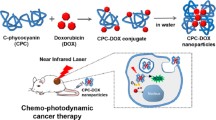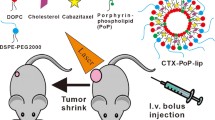Abstract
Pharmacokinetics and phototoxicity of purpurin-18 (Pp18) in human colon carcinoma cells (Colo-205) was studied using liposomes as delivery vehicles. Cytotoxicity was measured using 3-(4,5-dimethylthiazol-2-yl)-2,5-diphenyltetrazolium bromide (MTT) assay and neutral red uptake assay, and mode of cell death was assessed by the study of cell morphology and nuclear staining with Hoechst 33342-propidium iodide. Pp18 solubilized in dimethyl sulfoxide saline solution was observed to aggregate (Q-band absorption 740 nm), resulting in very poor cellular uptake. Pp18 incorporated in liposome remained in monomeric form (Q-band absorption 695 nm), but due to the presence of an anhydride ring in the molecule it readily yielded another photosensitizer, chlorin p6 (Q-band absorption 662 nm). Measurements at various pH showed that Pp18 in liposome was stable at acidic pH (6.5). Incubation of cells with 6.0 μM Pp18 in liposome at pH 6.5 showed a rapid cellular uptake. Spectrofluorometric measurements showed the presence of both Pp18 and chlorin p6, indicating conversion of some amount of Pp18 into chlorin p6 in the cells. Fluorescence microscopy revealed that the fluorescence was localized mainly in the cytoplasm, sparing the nucleus. Illumination of cells to white light after 4-h incubation with Pp18 liposome preparation was observed to lead to dose-dependent decrease in cell viability. At low irradiation time, cells displayed formation of plasma membrane blebs and micronuclei typical of apoptotic cell death. In contrast, at higher irradiation time, cell swelling and vacuolization in nucleus was observed, suggesting cell death due to necrosis. Irradiation with narrow bandwidth light showed that at low pH, the relative phototoxicity due to pp18 was higher than that due to chlorin p6. It is suggested that the pH-dependent conversion of pp18 to chlorin p6 can be exploited to increase PDT selectivity.







Similar content being viewed by others
References
Ochsner M (1997) Photophysical and photobiological processes in photodynamic therapy of tumors. J Photochem Photobiol B Biol 39:1–18
Derycke1 AS, de Witte PA (2004) Liposomes for photodynamic therapy. Adv Drug Deliv Rev 56:17–30
Damoiseau X, Schuitmaker HJ, Lagerberg JW, Hoebeke M (2001) Increase of the photosensitizing efficiency of the Bacteriochlorin a by liposome-incorporation. J Photochem Photobiol B Biol 60:50–60
Wang ZJ, He YY, Huang CG, Huang JS, Huang YC, An JY, Gu Y, Jiang LJ (1999) Pharmacokinetics, tissue distribution and photodynamic therapy efficacy of liposomal-delivered hypocrellin A, a potential photosensitizer for tumor therapy. Photochem Photobiol 70:773–780
Jiang F, Lilge L, Grenier J, Li Y, Wilson MD, Chopp M (1998) Photodynamic therapy of U87 glioma in nude rat using liposome-delivered Photofrin. Lasers Surg Med 22:74–80
Jiang F, Lilge L, Logie B, Li Y, Chopp M (1997) Photodynamic therapy of 9L gliosarcoma with liposome-delivered Photofrin. Photochem Photobiol 65:701–706
Lilge L, Wilson BC (1998) Photodynamic therapy of intracranial tissues: a preclinical comparative study of four different photosensitizers. J Clin Laser Med Surg 16:81–91
Hoober JK, Sery TW, Yamamoto N (1988) Photodynamic sensitizers from chlorophyll: purpurin-18 and chlorin p6. Photochem Photobiol 48:579–582
Mosman T (1983) Rapid colorimetric assay for cellular growth and survival application and cytotoxicity assays. J Immunol Methods 65:55–63
Lasarrow RM, Issero RR, Gomez EC (1992) Quantitative in vitro assessment of phototoxicity by fibroblasts—Neutral Red assay. J Invest Dermatol 98:725–729
Sousa C, Sa e Melo T, Geze M, Gaullier JM, Maziere JC, Santus R (1996) Solvent polarity and pH effects on the spectroscopic properties of neutral red: application to lysosomal microenvironment probing in living cells. Photochem Photobiol 63:601–607
Musser DA, Osero AR (1994) The use of tetrazolium salts to determine sites of damage to the mitochondrial electron transport chain in intact cells following in vitro photodynamic therapy with photofrin II. Photochem Photobiol 59:621–626
Sharma M, Dube A, Bansal H, Gupta PK (2004) Effect of pH on uptake and photodynamic action of chlorin p6 on human colon and breast adenocarcinoma cell lines. Photochem Photobiol Sci 3:231–235
Plaetzer K, Kiesslich T, Verwanger T, Krammer B (2003) The modes of cell death induced by PDT: an overview. Med Laser Appl 18:7–19
Fadeel B (2004) Plasma membrane alterations during apoptosis: role in corpse clearance. Antioxid Redox Signal 6:269–275
Brault D (1990) Physical chemistry of porphyrins and their interactions with membranes: the importance of pH. J Photochem Photobiol B 6:79–86
Friberg EG, Cunderlikova B, Pettersen EO, Moan J (2003) pH effects on the cellular uptake of four photosensitizing drugs evaluated for use in photodynamic therapy of cancer. Cancer Lett 195:73–80
Krammer B (2001) Vascular effects of photodynamic therapy. Anticancer Res 21:4271–4277
Das K, Jain B, Dube A, Gupta PK (2005) pH dependent binding of chlorin-p6 with phosphatidyl choline liposomes. Chem Phys Lett 401:185–188
Author information
Authors and Affiliations
Corresponding author
Rights and permissions
About this article
Cite this article
Sharma, S., Dube, A., Bose, B. et al. Pharmacokinetics and phototoxicity of purpurin-18 in human colon carcinoma cells using liposomes as delivery vehicles. Cancer Chemother Pharmacol 57, 500–506 (2006). https://doi.org/10.1007/s00280-005-0072-x
Received:
Accepted:
Published:
Issue Date:
DOI: https://doi.org/10.1007/s00280-005-0072-x




